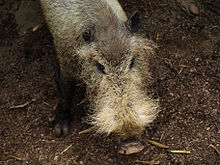Bornean bearded pig: Difference between revisions
Appearance
Content deleted Content added
Pics where the trademark beards show well |
Had wrong location |
||
| Line 5: | Line 5: | ||
| status_ref = <ref name=iucn>{{IUCN2006|assessors=Pigs & Peccaries Specialist Group|year=1996|id=41772|title=Sus barbatus|downloaded=12 May 2006}}</ref> |
| status_ref = <ref name=iucn>{{IUCN2006|assessors=Pigs & Peccaries Specialist Group|year=1996|id=41772|title=Sus barbatus|downloaded=12 May 2006}}</ref> |
||
| image = Bearded_Pigs2.jpg |
| image = Bearded_Pigs2.jpg |
||
| image_caption = At the [[ |
| image_caption = At the [[Philadelphia Zoo]] |
||
| image2 = Bearded-Pig.jpg |
| image2 = Bearded-Pig.jpg |
||
| image2_caption = At the [[San Diego Zoo]] |
| image2_caption = At the [[San Diego Zoo]] |
||
Revision as of 22:19, 7 January 2009
| Bearded Pig[1] | |
|---|---|

| |
| At the Philadelphia Zoo | |

| |
| At the San Diego Zoo | |
| Scientific classification | |
| Kingdom: | |
| Phylum: | |
| Class: | |
| Order: | |
| Family: | |
| Genus: | |
| Species: | S. barbatus
|
| Binomial name | |
| Sus barbatus Müller, 1838
| |
| Subspecies | |
The Bearded Pig (Sus barbatus), also known as the Bornean Bearded Pig, is a species of pig. It can be recognized by its prominent beard. It also sometimes has tassels on its tail. It is primarily found in Southeast Asia—Sumatra, Borneo, the eastern Philippines—where it inhabits rainforests and mangrove forests. The Bearded Pig lives in a family. It can reproduce from the age of 18 months, and can be cross-bred with other species in the family Suidae. There are about 25 members of this species in U.S zoos. The San Diego Zoo was the first zoo in the Western Hemisphere to breed them. The London Zoo is the only U.K zoo to currently house the species.[citation needed]
Subspecies
There are two subspecies of this pig:[1]
- Sus barbatus barbatus
- Western Bearded Pig (Sus barbatus oi)
External links
- Sus barbatus by Nicole Knibbe in University of Michigan Museum of Zoology
- Pigs, Peccaries and Hippos Status Survey and Action Plan (1993) Chapter 5.5 by Julian O. Caldecott, Raleigh A. Blouch and Alastair A. Macdonald.
References
- ^ a b Grubb, P. (2005). Wilson, D. E.; Reeder, D. M. (eds.). Mammal Species of the World: A Taxonomic and Geographic Reference (3rd ed.). Baltimore, MD: Johns Hopkins University Press. ISBN 0-8018-8221-4. OCLC 62265494.
- ^ Template:IUCN2006
Wikispecies has information related to Sus barbatus.
Wikimedia Commons has media related to Category:Sus barbatus.

